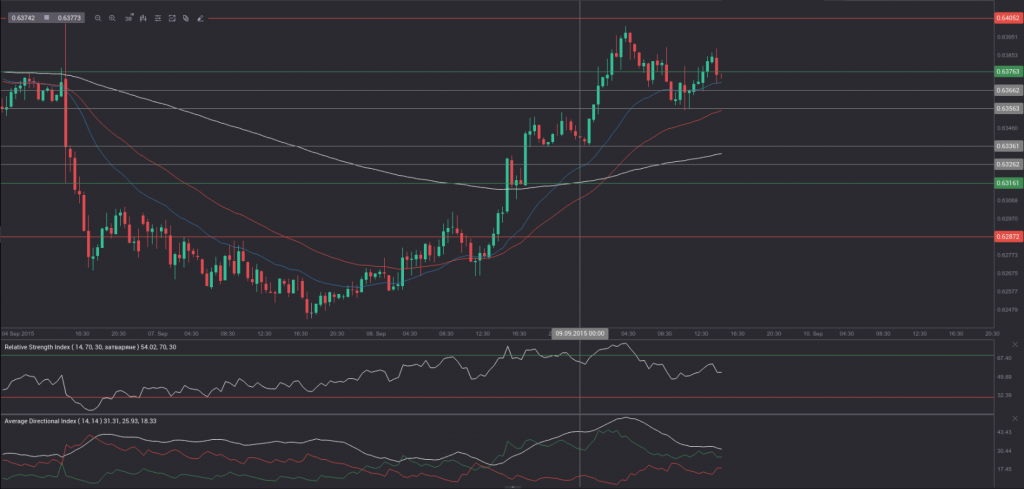 Yesterday’s trade saw NZD/USD within the range of 0.6251-0.6359. The pair closed at 0.6346, soaring 1.37% on a daily basis, or the most considerable daily gain since June 8th, when it appreciated 1.38%.
Yesterday’s trade saw NZD/USD within the range of 0.6251-0.6359. The pair closed at 0.6346, soaring 1.37% on a daily basis, or the most considerable daily gain since June 8th, when it appreciated 1.38%.
At 12:12 GMT today NZD/USD was gaining 0.58% for the day to trade at 0.6381. The pair tested the upper range breakout level (R4), as it touched a daily high at 0.6402 during mid-Asian trade. It has been the highest level since September 4th, when a daily high of 0.6408 was reached.
Today the cross may be influenced by a number of macroeconomic reports and events as listed below.
Fundamentals
New Zealand
RBNZ policy decision
The Reserve Bank of New Zealand (RBNZ) will probably cut its benchmark interest rate (the official cash rate) by 0.25% to 2.75% at the policy meeting today, according to market expectations. If so, this would mark the third consecutive rate reduction this year. In July the RBNZ stressed on the softer economic growth outlook and suppressed inflation rate, while hinting more rate cuts in the future.
According to extracts from the statement, taken by RBNZ Governor, Graeme Wheeler, following the banks most recent policy decision: ”New Zealand’s economy is currently growing at an annual rate of around 2.5 percent, supported by low interest rates, construction activity, and high net immigration. However, the growth outlook is now softer than at the time of the June Statement. Rebuild activity in Canterbury appears to have peaked, and the world price for New Zealand’s dairy exports has fallen sharply.”
”Headline inflation is currently below the Bank’s 1 to 3 percent target range, due largely to previous strength in the New Zealand dollar and a large decline in world oil prices. Annual CPI inflation is expected to be close to the midpoint of the range in early 2016, due to recent exchange rate depreciation and as the decline in oil prices drops out of the annual figure.”
”The New Zealand dollar has declined significantly since April and, along with lower interest rates, has led to an easing in monetary conditions. While the currency depreciation will provide support to the export and import competing sectors, further depreciation is necessary given the weakness in export commodity prices.”
”A reduction in the OCR is warranted by the softening in the economic outlook and low inflation. At this point, some further easing seems likely.”
Short-term interest rates are of utmost importance for the valuation of national currencies. In case the Reserve Bank of New Zealand is dovish about inflationary pressure and overall economic activity and, thus, decides either to maintain, or to reduce its benchmark rate, this will have a strong bearish effect on the kiwi dollar.
The official decision on policy is expected at 21:00 GMT.
United States
Job Openings
The number of job openings in the United States probably increased to 5.301 million in July from 5.249 million in June. The latter has been the lowest figure since March, when 4.994 million job openings were reported. This indicator refers to all positions that are open, but not filled on the last business day of the month. Job openings are part of the Job Openings and Labor Turnover Survey (JOLTS), which gathers data from about 16 400 non-farm establishments including retailers and manufacturers, as well as federal, state, and local government entities in the 50 states and the District of Columbia. The survey assesses the unmet demand for labor in the labor market. Higher-than-projected number of openings will usually have a limited bullish effect on the US dollar. The Bureau of Labor Statistics is to release the official data at 14:00 GMT.
Bond Yield Spread
The yield on New Zealands 2-year government bonds went as high as 2.585% on September 8th, or the highest level since August 27th (2.605%), after which it slid to 2.570% at the close to add 1.5 basis points (0.015 percentage point) on a daily basis. It has been a second consecutive trading day of gains.
The yield on US 2-year government bonds climbed as high as 0.657% on July 10th, or the highest level since July 2nd (0.716%), after which it fell to 0.645% at the close to gain 6 basis points (0.06 percentage point) for the day.
The spread between 2-year New Zealand and 2-year US bond yields, which reflects the flow of funds in a short term, shrank to 1.833% on September 8th from 1.838% during the prior day. The September 8th yield difference has been the lowest one since September 2nd, when the spread was 1.823%.
Meanwhile, the yield on New Zealands 10-year government bonds soared as high as 3.335% on September 8th, or the highest level since August 20th (3.365%), after which it slid to 3.315% at the close to remain unchanged in comparison with September 7th.
The yield on US 10-year government bonds climbed as high as 2.421% on July 10th, or the highest level since July 2nd (2.470%), after which it slipped to 2.401% at the close to add 8.4 basis points (0.084 percentage point) on a daily basis, while marking a second consecutive day of gains.
The spread between 10-year New Zealand and 10-year US bond yields narrowed to 1.127% on September 8th from 1.164% during the prior day. The September 8th yield spread has been the lowest one since September 2nd, when the spread was 1.092%.
Daily and Weekly Pivot Levels
By employing the Camarilla calculation method, the daily pivot levels for NZD/USD are presented as follows:
R1 – 0.6356
R2 – 0.6366
R3 (range resistance – green on the 30-minute chart) – 0.6376
R4 (range breakout – red on the 30-minute chart) – 0.6405
S1 – 0.6336
S2 – 0.6326
S3 (range support – green on the 30-minute chart) – 0.6316
S4 (range breakout – red on the 30-minute chart) – 0.6287
By using the traditional method of calculation, the weekly pivot levels for NZD/USD are presented as follows:
Central Pivot Point – 0.6344
R1 – 0.6421
R2 – 0.6558
R3 – 0.6635
S1 – 0.6207
S2 – 0.6130
S3 – 0.5993






